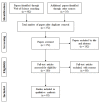A Comprehensive Review of Techniques for Processing and Analyzing Fetal Heart Rate Signals
- PMID: 34577342
- PMCID: PMC8469481
- DOI: 10.3390/s21186136
A Comprehensive Review of Techniques for Processing and Analyzing Fetal Heart Rate Signals
Abstract
The availability of standardized guidelines regarding the use of electronic fetal monitoring (EFM) in clinical practice has not effectively helped to solve the main drawbacks of fetal heart rate (FHR) surveillance methodology, which still presents inter- and intra-observer variability as well as uncertainty in the classification of unreassuring or risky FHR recordings. Given the clinical relevance of the interpretation of FHR traces as well as the role of FHR as a marker of fetal wellbeing autonomous nervous system development, many different approaches for computerized processing and analysis of FHR patterns have been proposed in the literature. The objective of this review is to describe the techniques, methodologies, and algorithms proposed in this field so far, reporting their main achievements and discussing the value they brought to the scientific and clinical community. The review explores the following two main approaches to the processing and analysis of FHR signals: traditional (or linear) methodologies, namely, time and frequency domain analysis, and less conventional (or nonlinear) techniques. In this scenario, the emerging role and the opportunities offered by Artificial Intelligence tools, representing the future direction of EFM, are also discussed with a specific focus on the use of Artificial Neural Networks, whose application to the analysis of accelerations in FHR signals is also examined in a case study conducted by the authors.
Keywords: artificial neural networks; biomedical signal processing and analysis; fetal heart rate; fetal heart rate variability; linear FHRV indices; nonlinear FHRV indices.
Conflict of interest statement
The authors declare no conflict of interest.
Figures




Similar articles
-
Multiparametric Investigation of Dynamics in Fetal Heart Rate Signals.Bioengineering (Basel). 2021 Dec 28;9(1):8. doi: 10.3390/bioengineering9010008. Bioengineering (Basel). 2021. PMID: 35049717 Free PMC article.
-
Developments in CTG analysis.Baillieres Clin Obstet Gynaecol. 1996 Jun;10(2):185-209. doi: 10.1016/s0950-3552(96)80033-2. Baillieres Clin Obstet Gynaecol. 1996. PMID: 8836480 Review.
-
Hybrid-FHR: a multi-modal AI approach for automated fetal acidosis diagnosis.BMC Med Inform Decis Mak. 2024 Jan 22;24(1):19. doi: 10.1186/s12911-024-02423-4. BMC Med Inform Decis Mak. 2024. PMID: 38247009 Free PMC article.
-
Linear and nonlinear analysis of heart rate patterns associated with fetal behavioral states in the antepartum period.Early Hum Dev. 2007 Sep;83(9):585-91. doi: 10.1016/j.earlhumdev.2006.12.006. Epub 2007 Jan 29. Early Hum Dev. 2007. PMID: 17261357
-
Use of artificial intelligence (AI) in the interpretation of intrapartum fetal heart rate (FHR) tracings: a systematic review and meta-analysis.Arch Gynecol Obstet. 2019 Jul;300(1):7-14. doi: 10.1007/s00404-019-05151-7. Epub 2019 May 3. Arch Gynecol Obstet. 2019. PMID: 31053949
Cited by
-
Detection of Suspicious Cardiotocographic Recordings by Means of a Machine Learning Classifier.Bioengineering (Basel). 2023 Feb 15;10(2):252. doi: 10.3390/bioengineering10020252. Bioengineering (Basel). 2023. PMID: 36829746 Free PMC article.
-
Advanced Predictive Analytics for Fetal Heart Rate Variability Using Digital Twin Integration.Sensors (Basel). 2025 Feb 27;25(5):1469. doi: 10.3390/s25051469. Sensors (Basel). 2025. PMID: 40096274 Free PMC article.
-
Evaluation of different machine learning algorithms for predicting the length of stay in the emergency departments: a single-centre study.Front Digit Health. 2024 Jan 8;5:1323849. doi: 10.3389/fdgth.2023.1323849. eCollection 2023. Front Digit Health. 2024. PMID: 38259256 Free PMC article.
-
Computerised Cardiotocography Analysis for the Automated Detection of Fetal Compromise during Labour: A Review.Bioengineering (Basel). 2023 Aug 25;10(9):1007. doi: 10.3390/bioengineering10091007. Bioengineering (Basel). 2023. PMID: 37760109 Free PMC article. Review.
-
Overcrowding analysis in emergency department through indexes: a single center study.BMC Emerg Med. 2022 Nov 18;22(1):181. doi: 10.1186/s12873-022-00735-0. BMC Emerg Med. 2022. PMID: 36401158 Free PMC article.
References
-
- Abdulhay E.W., Oweis R.J., Alhaddad A.M., Sublaban F.N., Radwan M.A., Almasaeed H.M. Review Article: Non-Invasive Fetal Heart Rate Monitoring Techniques. Biomed. Sci. Eng. 2014;2:53–67. doi: 10.12691/bse-2-3-2. - DOI
-
- Stylios C. IFMBE Proceedings. Volume 11. Springer; Berlin/Heidelberg, Germany: 2005. Methods and Tools for Processing Biosignals: A Survey Paper; pp. 1727–1983.
-
- Lobo Marques J.A., Cortez P.C., Madeiro J.P.D.V., Fong S.J., Schlindwein F.S., Albuquerque V.H.C.D. Automatic Cardiotocography Diagnostic System Based on Hilbert Transform and Adaptive Threshold Technique. IEEE Access. 2019;7:73085–73094. doi: 10.1109/ACCESS.2018.2877933. - DOI
-
- Cesarelli M., Romano M., Bifulco P., Improta G., D’Addio G. An Application of Symbolic Dynamics for FHRV Assessment. Volume 180. IOS Press; Amsterdam, The Netherlands: 2012. - PubMed
Publication types
MeSH terms
LinkOut - more resources
Full Text Sources

